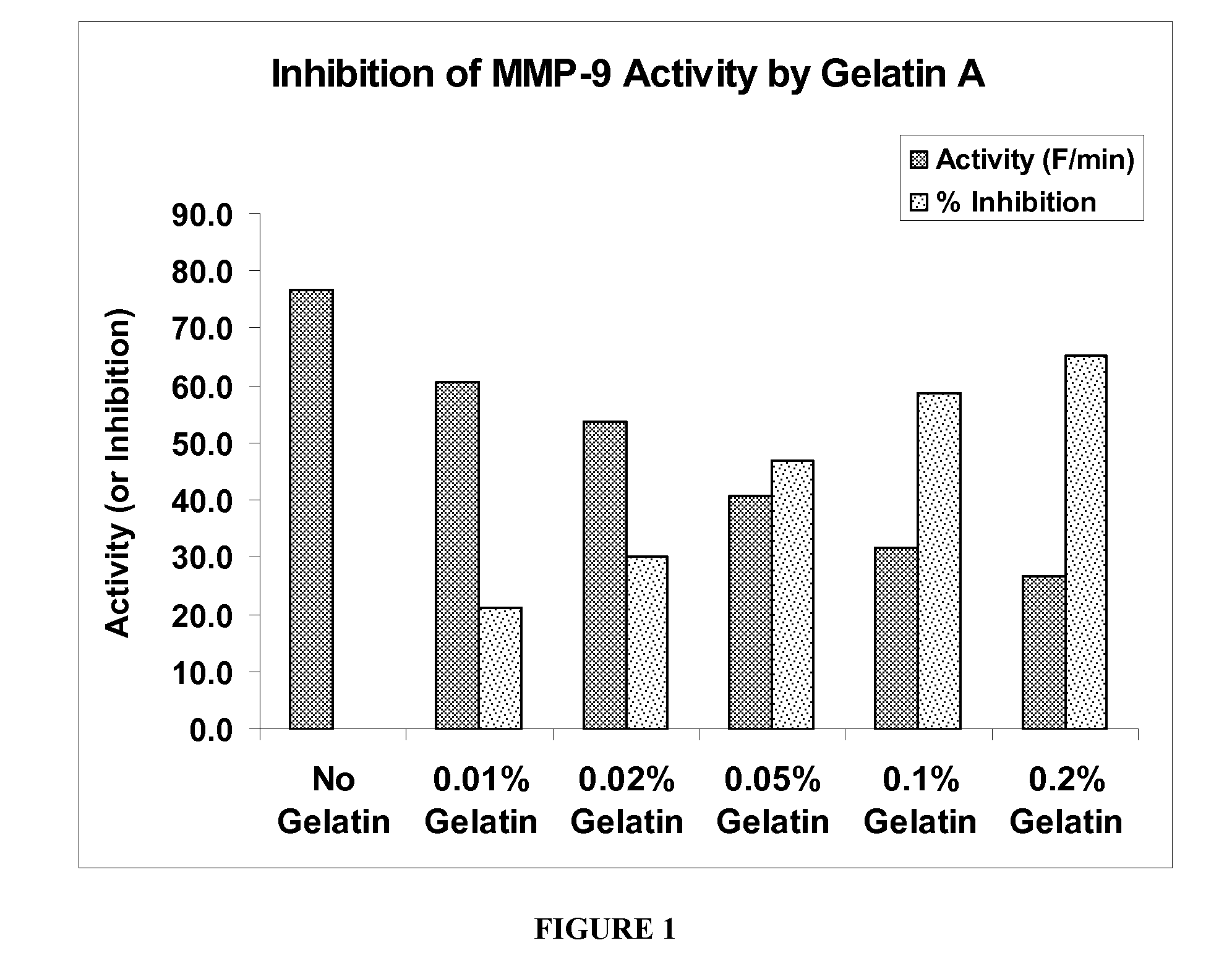Methods and compositions for treating dry eye
a technology of compositions and dry eye, applied in the field of methods and compositions for treating dry eye, can solve the problems of prolonged activity duration, and achieve the effects of prolonging the therapeutic action, reducing the ability of proteases, and reducing the direct damage effect of mmp-9
- Summary
- Abstract
- Description
- Claims
- Application Information
AI Technical Summary
Benefits of technology
Problems solved by technology
Method used
Image
Examples
example 1
[0063]In this and the following examples, unless otherwise indicated, MMP activity was assessed using fluorogenic substrates susceptible to MMP-1, -2, and -9, including DNP-Pro-Leu-Gly-Met-Trp-Ser-Arg-OH and DNP-Pro-Cha-Gly-Cys(Me)-His-Ala-Lys(N-Me-Abz)-NH2. These fluorogenic substrate assays are well known in the art; for example, see Bickett et al. Analytical Biochemistry 212, 58-64 (1993) and Netzel-Arnett et al., Analytical Biochemistry 195, 86-92 (1991), both of which are hereby incorporated into this disclosure by reference. Before conducting the assay the pro-MMP-9 was activated by p-aminophenylmercuric acetate and no activation of bacterial collagenase was required. For assay a stock solution of the substrate at 0.1 mM concentration in DMSO was prepared and all of the enzyme activity assays with or without inhibitors were performed in 50 mM tricine buffer, pH 7.5, containing 0.2M NaCl, 10 mM CaCl2, 50 mM ZnSO4, and 0.05% Brij-35 at room temperature. (Brij-35 is a commerciall...
example 2
[0065]This study was undertaken to investigate the potential of Gelatin A to inhibit MMP-9 activity when used with various demulcent polymers. For this purpose 0.1% w / v Gelatin A that provided approximately 59% inhibition from Example 1 was chosen. MMP-9=Calbiochem Cat# 444231;Lot# B56458; human neutrophil. Activity used was 200 μunits / assay. Gelatin=Gelatin A. Sigma Cat# 1890-50G, Lot# 014K0077 (an acid extract from porcine skin). Assay Buffer=50 mM Tricine, pH 7.5, containing 0.2M NaCl, 10 mM CaCl2. Substrate=MMP-1 / MMP-9 fluorogenic substrate. Calbiochem cat# 44221, lot# B54710. MWt, 1077.2; 1 μM in assay. Peptide structure=DNP-Pro-Cha-Gly-Cys(Me)-His-Ala-Lys(N-Me-Abz)-NH2. Ex, 365 nm; Em, 450 nm.
[0066]The results of this study show that Gelatin A at 0.1% w / v, in combination with 0.18% w / v HP-guar, 0.3% w / v HPMC and 0.5% w / v CMC, was able to provide 74.8%, 71.8% and 79.1 % inhibition of MMP-9 respectively, as shown in FIG. 2.
example 3
[0067]The next series of studies investigated the ability of Gelatin-A to inhibit MMP-9 activity when incorporated into two representative artificial tear solutions. For this purpose the artificial tear solutions known as Systane and Tears Naturale II were chosen. For this series of studies various concentrations of gelatin-A ranging from 0.01% to 0.20% (w / v) were incorporated into both of the marketed Systane and Tears Naturale II solutions. The assay was conducted using the same enzyme and substrate, and following the same procedure as described in Example 2. The results of this study demonstrate that Gelatin-A showed a dose response inhibition of MMP-9 activity when incorporated into both Systane and Tears Naturale II solutions, contributing more than 50% inhibition from 0.01% w / v and up in Systane, and from 0.05% w / v and up in Tears Naturale II. The results of these studies are described graphically in FIGS. 3 and 4.
PUM
| Property | Measurement | Unit |
|---|---|---|
| Fraction | aaaaa | aaaaa |
| Fraction | aaaaa | aaaaa |
Abstract
Description
Claims
Application Information
 Login to View More
Login to View More - R&D
- Intellectual Property
- Life Sciences
- Materials
- Tech Scout
- Unparalleled Data Quality
- Higher Quality Content
- 60% Fewer Hallucinations
Browse by: Latest US Patents, China's latest patents, Technical Efficacy Thesaurus, Application Domain, Technology Topic, Popular Technical Reports.
© 2025 PatSnap. All rights reserved.Legal|Privacy policy|Modern Slavery Act Transparency Statement|Sitemap|About US| Contact US: help@patsnap.com



